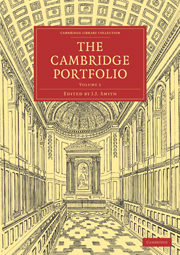Book contents
- Frontmatter
- DIRECTIONS FOR PLACING THE PLATES
- DESCRIPTION OF THE WOODCUTS
- LIST OF SIGNATURES
- ERRATA
- PREFACE
- INTRODUCTORY
- THE FIRST MILESTONE FROM CAMBRIDGE
- THE APPROACH AND PRINCIPAL AVENUE
- THE WALKS
- THE INSTALLATION IN 1835
- SOURCES OF HISTORY. I
- SOURCES OF HISTORY. II; COLLEGE HISTORIES
- A DREAM OF THE POETS
- MEMORIAL OF GONVILLE AND CAIUS COLLEGE
- FOVNDERS. I
- THE BOTANICAL GARDEN
- THE GOGMAGOGS
- TRINITY COLLEGE CHAPEL
- ON THE ANCIENT AMUSEMENTS OF THE UNIVERSITY
- A LEGEND OF THE HILLS
- SIGHED ON KING'S BRIDGE. OCT. 1838
- THE CAMBRIDGE PHILOSOPHICAL SOCIETY
- MUSEUM OF THE CAMBRIDGE PHILOSOPHICAL SOCIETY
- NOTICE OF WILLUGHBY
- THE BOAT-RACE
- NEVILLE'S COURT
- CRITIQUE ON GRAY
- AN INDEPENDENT TRIBUTE TO THE MEMORY OF THE RIGHT HON WILLIAM PITT
- SOURCES OF HISTORY. III: PRIVATE COLLECTIONS
- FOVNDERS. II
- PORTRAITURE OF DR. CAIUS
- THE UNION DEBATING SOCIETY
- ALABASTER
- CLARE HALL
- ORGANS
- POSTSCRIPT TO THE LEGEND OF THE HILLS
- ANECDOTES
- MILTON'S MULBERRY TREE
- BIOGRAPHICAL NOTICES
- The Cambridge Portfolio pp. 216-236
- VOCABULARY. I
- DR. LEGGE
- READING PARTIES
- THE CAM
- ANCIENT BRICK
- THE WOODWARDIAN MUSEUM
- THE COLLEGE COURSE
- THE CLUBS OF CAMBRIDGE
- OLD PLATE
- THE GARDEN AND COURTS OF GONVILLE AND CAIUS COLLEGE
- Plate section
- Frontmatter
- DIRECTIONS FOR PLACING THE PLATES
- DESCRIPTION OF THE WOODCUTS
- LIST OF SIGNATURES
- ERRATA
- PREFACE
- INTRODUCTORY
- THE FIRST MILESTONE FROM CAMBRIDGE
- THE APPROACH AND PRINCIPAL AVENUE
- THE WALKS
- THE INSTALLATION IN 1835
- SOURCES OF HISTORY. I
- SOURCES OF HISTORY. II; COLLEGE HISTORIES
- A DREAM OF THE POETS
- MEMORIAL OF GONVILLE AND CAIUS COLLEGE
- FOVNDERS. I
- THE BOTANICAL GARDEN
- THE GOGMAGOGS
- TRINITY COLLEGE CHAPEL
- ON THE ANCIENT AMUSEMENTS OF THE UNIVERSITY
- A LEGEND OF THE HILLS
- SIGHED ON KING'S BRIDGE. OCT. 1838
- THE CAMBRIDGE PHILOSOPHICAL SOCIETY
- MUSEUM OF THE CAMBRIDGE PHILOSOPHICAL SOCIETY
- NOTICE OF WILLUGHBY
- THE BOAT-RACE
- NEVILLE'S COURT
- CRITIQUE ON GRAY
- AN INDEPENDENT TRIBUTE TO THE MEMORY OF THE RIGHT HON WILLIAM PITT
- SOURCES OF HISTORY. III: PRIVATE COLLECTIONS
- FOVNDERS. II
- PORTRAITURE OF DR. CAIUS
- THE UNION DEBATING SOCIETY
- ALABASTER
- CLARE HALL
- ORGANS
- POSTSCRIPT TO THE LEGEND OF THE HILLS
- ANECDOTES
- MILTON'S MULBERRY TREE
- BIOGRAPHICAL NOTICES
- The Cambridge Portfolio pp. 216-236
- VOCABULARY. I
- DR. LEGGE
- READING PARTIES
- THE CAM
- ANCIENT BRICK
- THE WOODWARDIAN MUSEUM
- THE COLLEGE COURSE
- THE CLUBS OF CAMBRIDGE
- OLD PLATE
- THE GARDEN AND COURTS OF GONVILLE AND CAIUS COLLEGE
- Plate section
Summary
Most of the College Chapels have not an organ; in Emmanuel College the instrument is silent, as well as in Pembroke College. The following notices respecting the organs that are in use will be considered valuable for their authority and technical character.
The organ in the Chapel of Trinity College, which is justly considered the finest in Cambridge, and ranks among the first in England, was built originally by Father Schmidt in the year 1706 when Bentley was Master of the College, at a cost of £1500. It has since that time received many additions and improvements; the most considerable of which was made three years ago by Gray and Son of London. The compass of the great organ is from CCC the 16 feet pipe to F in alt. throughout all the stops. The swell, which is exceedingly fine, extends from gamut G to F in alt., and contains the following stops: open Diapason, stopped Diapason, double stopped Diapason, Principal, three rank Sesquialtra, Hautboy, Trumpet and Clarion. The choir organ is much admired for its sweetness of tone, and possesses a remarkably fine Cremona. There are two octaves of pedal pipes and many coupling stops, by means of which the power of the organ is much increased and great variety is obtained.
- Type
- Chapter
- Information
- The Cambridge Portfolio , pp. 194 - 195Publisher: Cambridge University PressPrint publication year: 2010First published in: 1840

